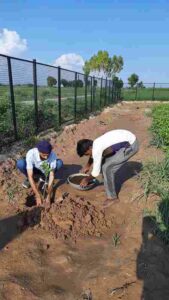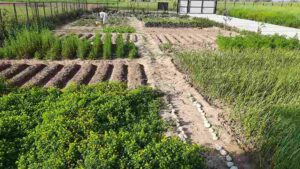Father-Son Duo’s Simple Idea Could Help Organic Farmers Earn Up To 194% More
Father son duo Sarbjit and Arshdeep Bahga run Bahga Farms, wherein they have decided to implement a simple farming technique that could reduce dependency on chemicals, increase yield, and help other farmers earn more.

In Ghel village of Punjab, two men have decided to change their district’s agrarian practices with a simple transformation in the thought pattern of farmers here.
Arshdeep Bahga and his father Sarbjit Bahga had a desire to return to their roots and create a sustainable and biodiverse organic farm that could serve as a model for farmers in the area.
This model is aimed at improving farmers’ livelihoods, increasing their income, and diving into the purview of organic farming.
A vision for the future of farming
Arshdeep, a tech entrepreneur, was working as a research scientist at Georgia Tech, USA, for six years, and decided to move back to India in 2016. Sarbjit, meanwhile, served as an architect in the Punjab Government and had a successful career that spanned 41 years.
Fueled by the zeal to enhance agrarian patterns in the region and boost farmers’ incomes, the duo came up with the idea of establishing a farm that reintroduced traditional practices of organic farming with a blend of modern technologies.
The Bahga Farm was started in the 2019-2020 time frame.
“We spent time with farmers in the region and realised that the use of chemicals to increase the yield of crops had a devastating impact on the land. Due to a lack of knowledge and experience, many farmers had destroyed their lands and over-exploited groundwater resources, leading to depletion of the water table,” says Arshdeep, recounting how these factors served as motivation behind starting Bahga Farm.
In the land of fertile soils, dotted with yellow mustard seeds and the toil of farmers, there is much opportunity for growth and good produce. But this is often affected by practices that are not sustainable, and conditions that are not well researched. In the search to find a way for farmers to maximise the profits they make, Arshdeep and his father came up with one such model.
He explains, “Presently, most farmers sow paddy and wheat and sell the crops in the agriculture produce (grain) markets due to the MSP (minimum support price) that they receive for these crops. Considering the average yield of 30 quintals per acre for paddy, and 20 quintals for wheat, the total grains procured per annum comes to be 50 quintals per acre. As per the prevailing MSP, these crops give a financial return of Rs 98,500 per acre per annum.”
However, simply wheat and rice are not enough to feed a farmer’s family, and they thus end up purchasing other food items including vegetables, pulses, herbs, and cooking oil from grocery shops at hefty prices. From the research that Arshdeep and his father conducted, they deduced that a rough estimate of the yearly purchase of food items by one family comes out to be Rs 1,50,000.
Thus, there is a gaping margin between how much a farmer’s family is earning through selling produce, and how much they need to spend on fulfilling their own food requirements.
The duo’s solution entails that instead of limiting themselves to a wheat rice monoculture on a five acre land, farmers can diversify their cropping patterns. For example, if a farmer owns a five-acre land, it can be divided into sections of one acre each where different crops can be grown. “This diversified cropping model is not only sufficient to meet the food requirements up to 90% but also gives maximum profits from the same piece of land,” claims Arshdeep.
The findings and methods of this sustainable model are discussed in the book that the duo has authored titled, Building a Sustainable and Bio-Diverse ORGANIC FARM: Case Study of a 1 Acre Model Farm in India. It covers their experiences of developing the farm and growing healthy, organic, and natural, farm-fresh vegetables, and can serve as a handy reference for readers who wish to start their own organic farm.
Has the model shown results?
Arshdeep says “Post the initial investment on land and farm equipment, Bahga Farm has now become self-sustaining. Through meticulous planning and adoption of organic and natural farming methods, we have been successful in minimising the input costs for agriculture while maximising output.”
Through the one acre farm concept, they are able to produce vegetables, herbs, pulses, oilseeds, fruits, and eggs from poultry, he says, adding that this integrated farming system leads to a yearly market value of approximately Rs 2,90,000 per acre, thus meeting and exceeding the amount that farmers would need to make food purchases.
Amrinder Singh from Rajindergarh village of Punjab is one farmer who has been inspired to follow this model. When we spoke to him, he said “Meine jab pehli baar Arshdeep ke farm model ko dekha, bohot alag tha. Jo hum sabzi mandi se khareedte hai, voh hum abhi khud ugaa sakte hai. (Arshdeep’s farm model was very different. Instead of buying our daily food crops from the market, we can now grow these ourselves.)”
He went on to add that every farmer in Punjab should follow this model, and that he himself is in the process of implementing it for his farm in the coming season.
An IT professional from Delhi-NCR, Prashant Sahni is another such person who has borrowed inspiration from Arshdeep’s model. “In the coming years, food shortages will hit. I found the concept that he (Arshdeep) has come up with impressive in terms of helping farmers boost income. We often eat foods that have pesticides and are not healthy. Organic farming on a large scale is not possible, so if each one of us takes up this challenge by ourselves, it will be great.”
Self-sustenance is another boon of this model. “At the Bhaga Farm, every inch of the land is utilised,” says Arshdeep. “The cultivated land has been demarcated into three pockets. The more significant chunk is earmarked for cultivating grains, pulses, etc, and other essential crops while the other two chunks are reserved for seasonal vegetables.”
Along with the Bahga Farm, their research led them to come up with the Zimi Bio Fertiliser and Pesticide (ZBFP). “This unique blend comprises a microbial solution containing nitrogen-fixing bacteria, phosphate and potassium solubilising bacteria, a herbal solution containing extracts of neem, pongamia and other medicinal plants, and a wetting agent.”
Arshdeep says they have achieved excellent results with ZBFP, which can be used for seed treatment before sowing, foliar spray, or soil application. It also helps promote plant growth, enhances yield, creates resistance against pests, and prevents bacterial, fungal, and viral diseases.
“As opposed to expensive chemical fertilisers and pesticides, which can cost up to Rs 20,000 per acre per year, the cost of preparation of this blend is less than Rs 2,000. Farmers can minimise their input costs if they adopt this blend and at the same time grow food free from harmful chemicals.”
As for how they wish to expand this concept and scale, Arshdeep says they wish to support new farmers and create awareness about organic farming and conduct free on-farm training programs and workshops for students and professionals.
“With the shrinking land holdings in Punjab, and India in general, we aim to provide a viable model for the marginal farmers.”
This story made me
- 97
- 121
- 89
- 167
Tell Us More
We bring stories straight from the heart of India, to inspire millions and create a wave of impact. Our positive movement is growing bigger everyday, and we would love for you to join it.
Please contribute whatever you can, every little penny helps our team in bringing you more stories that support dreams and spread hope.



















